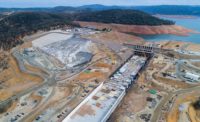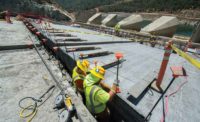As engineers at California’s Oroville dam began to investigate what led to the failure of the main spillway during heavy runoff in February and analyze solutions, they looked for help nearly a thousand miles east, reaching out to Utah State University’s Water Research Laboratory in Logan, Utah.
“We realized there were several work elements that would have to happen in the next few months to have our repair plan in place,” says Ted Craddock, project manager for the California Dept. of Water Resources at the Oroville emergency recovery spillway project, now underway. “One of those was to have a physical model of the proposed repairs. Utah State was one of the first calls we made.”
In connection with USU’s agricultural mission as a land-grant university, WRL engineers over decades have developed an expertise in the physical modeling of water projects.
The spillway collapse was not the first time the WRL and Oroville teams have worked together. In 2010, when the dam’s river-valve outlet system was damaged, WRL helped to design a solution to continue releases of water during the ensuing drought years, in 2014 and 2015.
During that incident, Oroville officials had “visited our lab several times and became familiar with our capabilities,” says Michael Johnson, WRL and USU civil engineering and research professor. In early March, dam officials again reached out and awarded WRL a $277,000 contract for research work on the spillway.
“We began with a model of how the spillway failed, and we’ve moved on to looking at a possible final configuration that is still to be determined,” says Johnson.
The goal is to have the spillway repaired to a usable condition by Nov. 1, Craddock says. “The target for this fall is to be able to safely pass flood flows we may see in the 2017-18 rainy season.
November 1 is a public-safety deadline, and we want to be able to put water down that spillway if we have to use it,” he adds.
Accurate Model
A team of 10 researchers and students built the 1:50-scale spillway model in about 40 days, using the DWR’s LIDAR imaging data. Made of wood, concrete, steel and plastic, the approximately 60-ft-wide by 120-ft-long model is equipped with sensors and monitors. A laboratory valve system can be opened to deluge the model at varying amounts and rates. Researchers can climb the structure to make measurements by hand and video recordings.
“We’ve had larger models here before, but most of that space was reservoir, so this is probably the largest model we’ve done as far as the constructed portion,” says Johnson. “We can collect data on water depth, flow rates and pressure. We have video, observation and quantitative data.”
The research at WRL will help to corroborate what engineers found using computational and numerical models and, before repairs, helps the project team to understand the flow characteristics of the existing terrain. “It also lets us look at an intermediate option and the fully restored chute,” says Craddock. “We’re examining the hydraulic and flow characteristics under different scenarios.”
WRL research engineer Zachary Sharp says the teams are working closely on the final design of the spillway. “There is a lot of collaboration going on between the numerical and physical modeling. We feed them information, and they feed us information. The model is giving design engineers more confidence in what they are designing,” says Sharp.
The team currently is evaluating the addition of aerators to the final spillway design. Aerators can help to prevent concrete cavitation, which may have been a contributing factor in the failure, according to early reports from the DWR forensics team.
Meanwhile, work on the damaged spillway and other components of the dam’s release systems continues to progress under a $275-million design-bid-build contract to Kiewit Infrastructure West.
“We needed to get the contractor mobilized, but we knew the package would have some major revisions as we worked through the process,” says Craddock.
Kiewit has been at work since last month demolishing the damaged portions of the spillway and prepping for repairs.
Erin Mellon, a California Natural Resources Agency spokeswoman, noted that about 1,000 ft of the upper spillway will remain in place this year. The collapsed section will be patched and the lower section of the spillway repaired using roller-compacted concrete, with structural concrete expected to be placed in August.
“The goal is to be able to run 100,000 cfs over it this winter if we need to,” Mellon adds.
Crews also will install a new cutoff wall downstream from the emergency spillway.
The WRL researchers plan to issue a report on their work in late fall. Work on a final solution for the spillway and other flood-control components of the dam will continue next summer.
Related: New Hudson River Tunnel Plan Faces Rising Costs, Questionable Support







Post a comment to this article
Report Abusive Comment